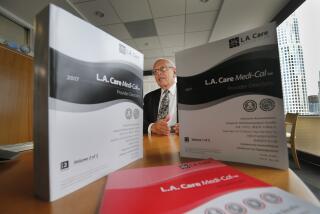Check Options Before Buying Dental Plan
The advertisements can sound too good to be true. A dental plan for $5 a month?
Most likely it’s a prepaid individual dental plan--a growing business. In Southern California, a variety of such plans is available, ranging from $4 to $25 a month. The growth is fueled, say industry experts, by employees turned self-employed people, retirees and workers who have lost dental benefits or never had them.
The trick, of course, is deciding which plan will provide the best care for the least outlay.
Deciphering the plans takes the same patience and attention as analyzing traditional health insurance plans. With individual prepaid dental plans, you pay monthly or annual fees in exchange for services offered by participating dentists at reduced rates or at no charge. A list of procedures and the co-payments is provided. Such preventive care as cleaning, for instance, is often offered at no extra charge. Restorative work like fillings and crowns is offered for a reduced fee or co-payment.
How to decide which plan is best for you?
First check out the company with the state Department of Corporations, which regulates these plans in California.
Next, see if the dentists you are considering practice in your area, suggests Dr. James Freed, a UCLA clinical professor of public health dentistry. Usually, a list is included in the plan’s informational packet.
“You ought to have two or three choices of dentists near where you live or work,” says Keith Macumber, spokesman for National Dental Health in San Diego, which offers the Dental Advantage plan.
The next step is to shop around and check out dentists thoroughly. “Look around for general cleanliness,” he says. Among questions to ask the office manager or dentist: “How quickly can I be seen for emergencies? For routine care?”
Examine the plan’s brochure. “Look for a broad range of coverages,” Macumber advises. It should offer more than such preventive care as teeth cleaning.
About one-third of dental expenses involve preventive care, Macumber says. Another third involves routine restorations like amalgam fillings and the other third goes for major restorations like crowns and bridgework.
“You want a dental plan that approximates that (in coverage),” he says. “And the preventive work is fairly low cost, so often you can expect 100% coverage in that area. As the cost increases, of course, the level of coverage decreases.”
In general, says Freed, the higher the monthly premium, the lower the co-payment, and vice versa.
“Look at the exclusions and limitations,” Freed suggests. One typical exclusion is oral surgery requiring the setting of fractures or dislocation. Some plans don’t cover broken orthodontic appliances.
Pre-existing conditions like gum disease don’t often make you an unacceptable subscriber, Freed says, although if you have “work in progress” your plan might not want to take up where your former dentist left off. If your former dentist started a crown, for instance, your new plan might not pay for the rest of the work.
Other points to ponder:
* Will the plan cover emergency services out of area? What happens, for instance, if you suddenly need a root canal while on vacation?
Out-of-area service reimbursement can vary. One plan offers to reimburse up to $25 for emergency services provided by a non-member dentist if the patient is more than 50 miles from a personal dentist. Another plan limits such reimbursement to $50 per member annually.
* Could you pick one dentist and your partner another?
Plans often stipulate one dental office per family.
* What if you need a specialist?
You might need to consult the plan and use one of its participating specialists.
*
Once you’re signed up and happy, be wary if your plan suddenly justifies a rate increase by comparing its costs to escalating costs for medical care, the California Dental Assn. warns. Problems affecting oral health are often preventable, the CDA points out, making catastrophic dental coverage unnecessary in general. So beware of a dental plan that justifies exorbitant rate increases by comparing their costs to medical care costs, which the CDA says is like comparing apples to oranges.
*
For more information: The Department of Corporations maintains a list of licensed plans. Call (916) 324-8176 to find out if a specific plan is on the list.
For a brochure, write California Dental Assn., “Dental Coverage,” P.O. Box 13749, Sacramento, Calif. 95853-4749. Include a self-addressed stamped envelope.
For a list of California companies offering individual dental plans, write the California Assn. of Prepaid Dental Plans, 300 Plaza Alicante, Box 5110, Garden Grove, Calif. 92640.
More to Read
Inside the business of entertainment
The Wide Shot brings you news, analysis and insights on everything from streaming wars to production — and what it all means for the future.
You may occasionally receive promotional content from the Los Angeles Times.










